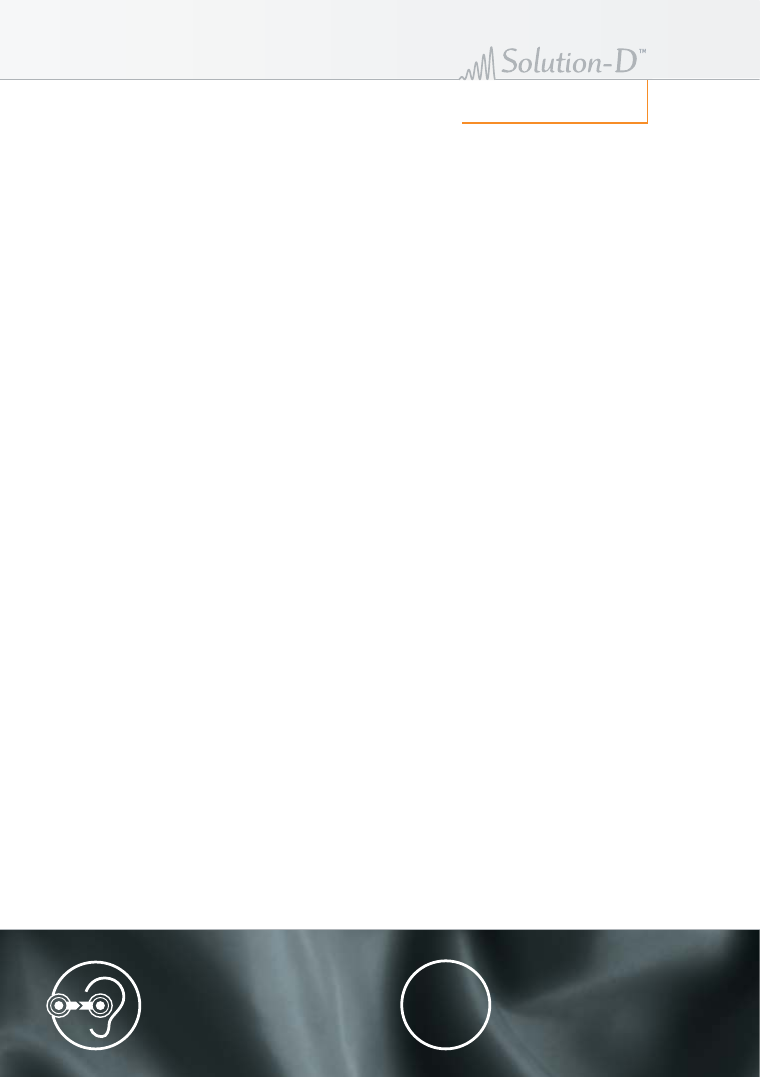
5
A/D
The System
Description
essary preconditions for the implementation of digital micro-
phone technology.
The Solution-D digital microphone system consists of the fol-
lowing components: The digital microphone (the D-01 and
TLM 103 D large-diaphragm and KM D small-diaphragm mi-
crophones are now available); the Digital Microphone Inter-
face (DMI); and the Remote Control Software (RCS), which fa-
cilitates the operation and permits the remote control of the
microphones. A PC or Mac can serve as the control computer,
which of course can also be used simultaneously as Didital
Audio Workstation for recording. The DMI permits connection
to all subsequent devices that have an AES/EBU interface.
As an alternative to a DMI, a „Connection Kit“ can be used to
connect Solution-D microphones to the AES/EBU or S/PDIF in-
terface of a recording system. However, if a Connection Kit is
used, it is not possible to control the microphone functions re-
motely. Thus a control computer is not required. In this case,
if it is necessary to synchronize several microphones, a sam-
ple rate converter must be used.
All of the possible Solution-D system configurations are illus-
trated on the following pages.
Starter Sets, containing a microphone and a Connection Kit,
provide an economically attractive entry to the world of digi-
tal microphones. If users later wish to take advantage of addi-
tional adjustable parameters and remotely controlled func-
tions, the system can be expanded at any time through the
acquisition of a separate DMI.
Remote control of standard microphone
parameters
The DMI digital microphone interface permits familiar micro-
phone settings such as the directional characteristic, pre-at-
tenuation and low-cut filter to be controlled remotely and
saved. Changing the settings of microphone parameters is
greatly simplified, which makes it possible for settings to be
tested rapidly from the monitoring position, in order to opti-
mize the sound quality. All of the settings can be saved to-
gether with any desired additional information, thus elimi-
nating the necessity of keeping a hand-written log of the
recording procedure.
Integrated digital audio signal processing
An A/D converter, developed and patented by Neumann, re-
ceives the signal directly from the capsule, and is optimized
for the specific signal and impedance parameters of the cap-
sule. Level matching that may be desired for subsequent
equipment takes place in the digital domain, in the micro-
phone. Analog components such as preamplifiers and A/D con-
verters are thus no longer required, resulting in considerable
cost savings.
The special A/D converter technology makes it possible to
have the complete dynamic range of the microphone capsule
available in the digital domain, with no restrictions. Setting
gain levels is therefore no longer critical.
A particularly significant feature is the peak limiter function.
Located for the first time in the most effective position, at
the signal source, it reduces transient peaks as the level
reaches 0 dBFS, when distortion would normally be inevita-
ble. Analog microphones require extensive headroom in the
subsequent signal path to handle such signal peaks, which are
short but have a large amplitude. Independently of the peak
limiter, a compressor/limiter can also be activated, permit-
ting detailed adjustment via the corresponding parameters.
In addition, functions such as mute and phase reverse are also
integrated into the microphone. Visual commands such as „On
air“ are implemented by means of remotely controlled LEDs in
the D-01 microphone. Acoustic commands in the form of vari-
ous test signals can be used to facilitate line checks.
The firmware of all the digital microphones can be updated
via uploading at any time.
Data transmitted by the microphone
Information transmitted by the microphone includes the name
of the manufacturer, the model and serial number, the soft-
ware version installed in the microphone, and the remotely
controllable functions that are supported by the microphone.
Status indicators such as „ready for operation“ and specific
warning functions are also transmitted.
A/D conversion
Despite continuing improvements, integrated circuits avail-
able on the market still constitute a limiting factor in the con-
version of audio data from analog to digital form. The best
currently available delta-sigma A/D converters typically
achieve a dynamic range of 115 dB to 120 dB, A-weighted,
with a word length of 24 bits.
In comparison, a high-quality analog condenser microphone
has a dynamic range of up to 130 dB. A/D conversion with a
TRUE TO THE ORIGINAL:
The satisfaction of recording
the uncolored original, with
no "bottlenecks" between the
capsule and the recording
system.
TRUE CONVERSION:
The guarantee of having
one of the best A/D
converters available.


















